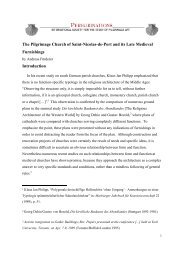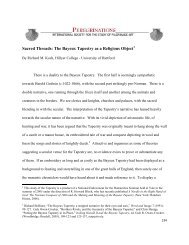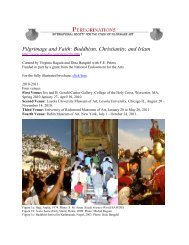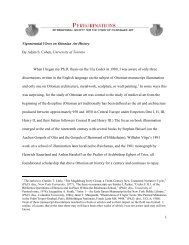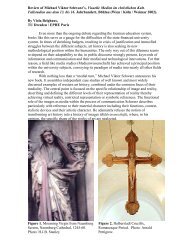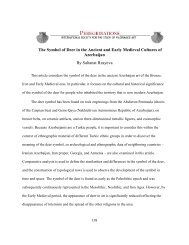The Bayeux Tapestry and the Vikings - Peregrinations
The Bayeux Tapestry and the Vikings - Peregrinations
The Bayeux Tapestry and the Vikings - Peregrinations
You also want an ePaper? Increase the reach of your titles
YUMPU automatically turns print PDFs into web optimized ePapers that Google loves.
<strong>the</strong> major concerns of <strong>the</strong> school curriculum? Perhaps <strong>the</strong> designer of <strong>the</strong> movie’s credits<br />
had visited <strong>Bayeux</strong> in <strong>the</strong> 1950s <strong>and</strong>, having seen <strong>the</strong> <strong>Tapestry</strong> when it was exhibited in<br />
its former home in <strong>the</strong> Bishop’s Palace, decided it would serve his purpose. Perhaps he<br />
was familiar with a book on <strong>the</strong> <strong>Bayeux</strong> <strong>Tapestry</strong>, something like <strong>the</strong> comprehensive<br />
study edited by Sir Frank Stenton which first appeared in 1956. We will never know if<br />
he was aware of <strong>the</strong> long <strong>and</strong> convoluted history which links Sc<strong>and</strong>inavia, <strong>the</strong> <strong>Vikings</strong>,<br />
<strong>and</strong> <strong>the</strong> <strong>Bayeux</strong> <strong>Tapestry</strong>.<br />
<strong>The</strong> question of <strong>the</strong> relationship between Sc<strong>and</strong>inavia, <strong>the</strong> <strong>Vikings</strong>, <strong>the</strong> Norman<br />
Conquest of Engl<strong>and</strong>, <strong>and</strong> <strong>the</strong> <strong>Bayeux</strong> <strong>Tapestry</strong>, has been discussed from <strong>the</strong> viewpoint of<br />
archaeology <strong>and</strong> art. It is equally necessary to investigate it from <strong>the</strong> st<strong>and</strong>point of<br />
national attitudes <strong>and</strong> interests, for it is possible to interpret <strong>the</strong> <strong>Bayeux</strong> <strong>Tapestry</strong>, <strong>the</strong><br />
Anglo-Saxons, <strong>and</strong> <strong>the</strong> <strong>Vikings</strong> as nineteenth-century century creations. <strong>The</strong> ways we<br />
look at <strong>the</strong>se phenomena <strong>and</strong> <strong>the</strong> questions we ask of <strong>the</strong>m were formulated during <strong>the</strong><br />
post-Napoleonic period when national identity was a major concern, <strong>and</strong> many European<br />
countries were reconstructing <strong>the</strong>ir own early histories.<br />
* * *<br />
<strong>The</strong> <strong>Bayeux</strong> <strong>Tapestry</strong> depicts certain carefully chosen events from <strong>the</strong> years 1064<br />
to 1066. In <strong>the</strong> embroidery images, <strong>and</strong> in modern English-language history books, <strong>the</strong><br />
Battle of Hastings <strong>and</strong> <strong>the</strong> ensuing “Norman” Conquest of Engl<strong>and</strong> are most often<br />
described as a bloody encounter between <strong>the</strong> Normans <strong>and</strong> <strong>the</strong>ir allies on <strong>the</strong> one side <strong>and</strong><br />
<strong>the</strong> Anglo-Saxons on <strong>the</strong> o<strong>the</strong>r, with <strong>the</strong> prize being <strong>the</strong> crown of Anglo-Saxon Engl<strong>and</strong>.<br />
14



